Home Remedies to Get Rid of Heel Pain
Written by Jessica Lal on March 24, 2023
Pain in the heel is pretty common and causes a lot of discomfort. It can be due to excessive pressure on the heel, and it can affect the ankle and the foot.
Anyone can experience heel pain. It is not restricted to the elderly.
Heel pain can be extremely bothersome because the heels are naturally designed to hold body weight and adjust to all movements of the body. The soreness usually occurs beneath the heel, although it can also be felt in other areas around the heel. (1)
If heel pain increases beyond control, it can be very hard to manage and can lead to poor quality of life. It can disrupt daily life and hamper day-to-day chores. It can also lead to the inability to walk.
To manage or get rid of heel pain, you can try some at-home remedies.
Heel Pain Relief Using Herbal Remedies
The following herbal remedies can bring relief from heel pain.
1. Use aloe vera
A common cause of heel pain is inflammation in the tissues that run across the bottom of the foot. These tissues connect the heel bone to the toes. The condition is termed plantar fasciitis.
Aloe vera is known for reducing inflammation. It has anti-inflammatory properties that can be helpful for managing heel pain in patients with plantar fasciitis.
How to use aloe vera for heel pain:
- Cut a leaf from an aloe vera plant and remove the thorny edges.
- Cut the leaf lengthwise to expose the gel inside.
- Apply the gel directly to the heel area.
- Gently massage the area using circular motions with your fingertips for 5–10 minutes.
- Continue the massage until the gel is fully absorbed.
- Repeat this process twice a day, preferably in the morning and before bedtime.
2. Drink willow bark tea
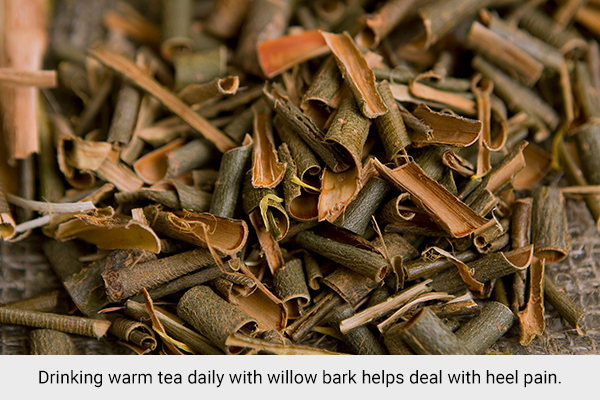
There is evidence to support that willow bark has a moderate effect in treating pain. Willow bark can also be a useful and safe treatment for inflammation, thus can be beneficial for patients with plantar fasciitis.
Drinking warm tea daily with willow bark helps deal with heel pain.
How to make willow bark tea:
- Obtain dried willow bark. You can purchase dried willow bark from health food stores, herbal shops, or online. Make sure to buy from a reputable source to ensure that the willow bark is of good quality.
- Bring a pot of water to a boil.
- Once the water has come to a boil, add 1–2 teaspoons of dried willow bark per cup of water to the pot.
- Reduce the heat, and let the willow bark simmer for 10–15 minutes.
- Use a fine-mesh strainer or cheesecloth to strain the liquid, removing any solids.
- Pour the willow bark tea into a mug and enjoy. You can add honey or lemon to taste if desired.
3. Try using ginger
Ginger is helpful and can be effective in reducing the development and progression of pain, especially in plantar fasciitis, because of its anti-inflammatory properties. It can also reduce the soreness associated with plantar fasciitis.
Studies have shown that ginger reduces the activity of several chemicals that are responsible for the inflammatory responses in the body. The good news is that ginger is easily available and is a staple in most kitchens.
How to use ginger topically:
- Obtain ginger oil or fresh ginger. Ginger oil can be purchased from health food stores or online. Alternatively, fresh ginger root can be grated or chopped.
- If using ginger oil, dilute it with a carrier oil such as coconut oil or sweet almond oil. Mix 3–4 drops of ginger oil with 1 tablespoon of carrier oil.
- Use your hands to massage the oil mixture onto the heel and surrounding areas. Apply gentle pressure and use circular or sweeping motions.
- You can perform the ginger oil massage once or twice a day or as needed to manage your heel pain.
How to use ginger orally:
- Obtain fresh ginger root. Fresh ginger root can be purchased at grocery stores or farmers’ markets.
- Use a vegetable peeler, remove the skin from the ginger root, and then slice it into small pieces.
- Add the sliced ginger root to a pot of boiling water and let it steep for 10–15 minutes. Alternatively, you can use a tea infuser or tea bags.
- Pour the ginger tea into a mug and enjoy. You can add honey or lemon to taste if desired.
Heel Pain Relief Using Temperature and Massage Therapy
The following interventions can help reduce heel pain.
1. Try heat therapy
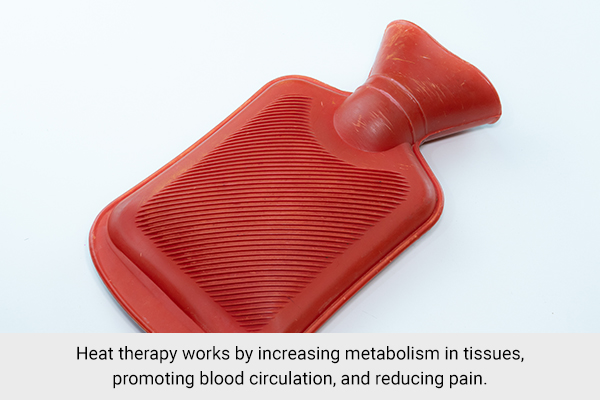
Heat therapy, specifically the use of a hot pack, can be effective in providing pain relief for patients with pain. Heat therapy works by increasing metabolism in the tissues, promoting blood circulation, and reducing pain.
Heel pain can be caused by a number of factors, including plantar fasciitis, Achilles tendonitis, and heel spurs. These conditions are often associated with inflammation and/or muscle strain. Heat therapy can be helpful in reducing inflammation and muscle tension, both of which can contribute to heel pain.
Overall, based on the research, heat therapy can be a promising candidate for clinical application in the management of heel pain.
How to use heat therapy:
- Apply a hot pack to the affected area for 15–20 minutes at a time, several times a day.
- Alternatively, a hot/warm water immersion or sauna may also be used.
2. Take an Epsom salt bath
Magnesium, found in Epsom salt, has been used for centuries in medicine to treat a variety of conditions, including abdominal pain, constipation, and muscle strains. More recently, magnesium has been widely used in modern medicine for the prevention and treatment of pain.
Studies have investigated the effectiveness of magnesium in reducing pain for surgical patients. The first study exploring the use of magnesium sulfate during surgery was published in 1996, and since then, many researchers have reported its pain-relieving effects.
Epsom salt baths, which contain magnesium sulfate, can be a potential method for managing heel pain. The magnesium in Epsom salt can help alleviate muscle tension and reduce inflammation, which are common causes of heel pain.
How to perform an Epsom salt bath
- Fill a bathtub with warm water that’s comfortable for you. Make sure there’s enough water to cover your feet.
- Add 1–2 cups of Epsom salt to the warm water. Stir the water with your hand or foot to dissolve the salt.
- Soak your feet in the Epsom salt bath for 15–20 minutes. You can also use a smaller basin or tub that’s just big enough for your feet if you prefer.
- While soaking, gently massage your feet to help the magnesium in the Epsom salt penetrate the skin and muscles.
- After soaking, gently pat your feet dry with a towel.
3. Perform a cross friction massage
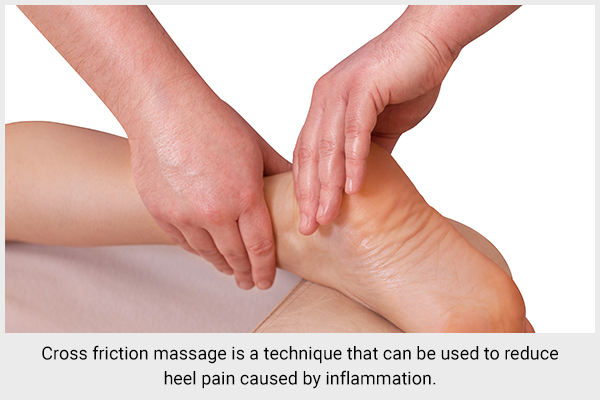
Cross friction massage is a technique that can be used to reduce heel pain caused by inflammation.
Research shows this technique helps to break down the scar tissue, promote the growth of new collagen fibers, and improve flexibility in the affected area.
To perform cross friction massage:
- Using your fingers or a massage tool, apply light pressure to the affected area, moving back and forth.
- Increase the pressure gradually, but do not apply too much pressure as it can cause further damage to the tissue.
- Continue massaging for a few minutes or until the area feels less tender.
4. Oil massage can help
Essential oils derived from plants are utilized for their therapeutic properties in aromatherapy, which involves the absorption of these oils through the skin or olfactory system to treat illnesses and improve physical and psychological well-being.
The most common methods of application are topical use and inhalation, with topical use involving mixing the oil with a carrier oil and using it for massage.
A study suggests that aromatherapy massage using ginger oil can be effective in reducing pain and improving mobility in individuals with heel pain. The long-term effects of the treatment were also found to be better compared to traditional Thai massage without any oil.
To perform an essential oil massage for heel pain
- Choose a carrier oil to dilute the essential oil before it is applied to the skin.
- Choose an essential oil. Ginger oil has been found to be effective in reducing pain and inflammation. Other essential oils that may be helpful for heel pain include peppermint oil, lavender oil, and eucalyptus oil.
- Add a few drops of the essential oil to the carrier oil and mix well. The exact amount of essential oil will depend on your personal preference and the recommended dilution ratio for the specific oil you are using.
- Using your hands, apply the oil mixture to the affected area and massage it onto the heel and surrounding areas.
- Apply gentle pressure and use circular or sweeping motions. Avoid applying too much pressure or massaging too aggressively, as this can cause further pain or discomfort.
5. Use ice therapy
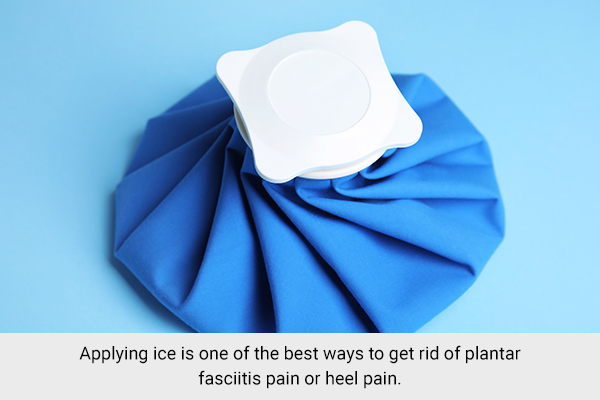
Temperature therapy is always good for pain. Applying ice is one of the best ways to get rid of plantar fasciitis pain or heel pain. It promotes healing by constricting the blood vessels, leading to the settling down of swelling and inflammation.
How to use:
- Take a bag of ice cubes or an ice pack.
- Wrap it in a cloth.
- Apply it to the areas of your feet where you experience pain.
Heel Pain Relief Using Lifestyle Interventions
Sometimes, simple changes in lifestyle are all it takes to make heel pain go away.
1. Ensure proper rest
Heel pain can be caused by lifestyle issues that aren’t due to any underlying disease. This includes being very active in high-impact sports, prolonged time spent on feet, overexertion, and long walks or marathons.
Resting is, therefore, important to take away some pressure off your feet and to reduce pain and swelling. It’s important to take it lightly and rest to keep the weight off your foot at least until the inflammation goes down.
2. Incorporate adequate vitamins in your diet
It has been observed that patients with heel pain, mainly due to plantar fasciitis, have a deficiency of vitamin D. Therefore, to get relief from heel pain, you may need supplementation with vitamin D.
You can also try incorporating vitamin D-rich foods into your diet. Foods that are good sources of vitamin D include:
- Milk
- Egg yolk
- Red meat
- Salmon
- Mushrooms
- Cheese
- Almond milk
Magnesium-rich foods can be good for managing pain, too. According to experts, you can add the following to your diet:
- Spinach
- Kale
- Almonds
- Pumpkin seeds
- Lentils
- Avocado
- Whole grains
3. Try losing weight
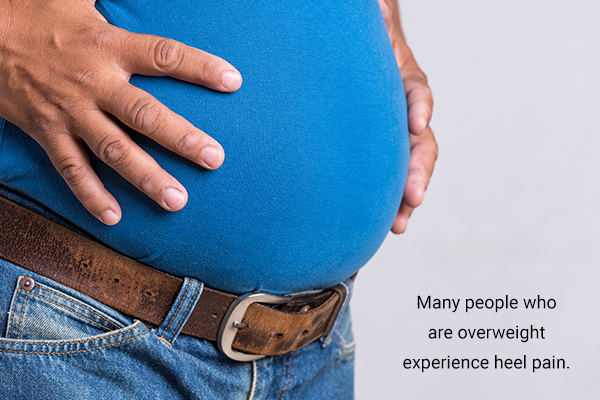
Obesity can also cause pain in the foot. The feet have to endure the extra weight put on the feet while moving around or doing daily chores.
Many people who are overweight experience heel pain. Thus, obesity can also be seen as a potential cause of plantar fasciitis.
Doing low-impact exercises is helpful in keeping you active while aiding weight loss and, thereby, reducing the stress on your feet. Try swimming, aerobics, or yoga.
Weight loss also reduces the fat in the plantar fascia, and as it regains flexibility, heel pain will subside.
4. Wear supportive shoes
Supportive shoes are designed to provide arch and heel support. They are good for avoiding any inflammation due to plantar fasciitis. They are usually lightweight with cushion pads.
The right shoe choice is extremely important to stay active throughout the day and also be on your feet without pain and inflammation.
Treating the cause of heel pain is important. This can be done by adjusting your footwear. To achieve this, you can opt for shoe insoles or inserts, also known as foot pads. They can be customized according to your need and requirement.
5. Wear splints
Wearing a splint at night can help with heel pain. Splints are different from shoes. Splints are devices used to immobilize and support a specific body part to promote healing and prevent further injury.
Because splints hold your plantar fascia stretched while you sleep, they can be helpful for managing heel pain. The stretching of these tissues during sleep reduces the stress caused by continuous movement and weight bearing.







